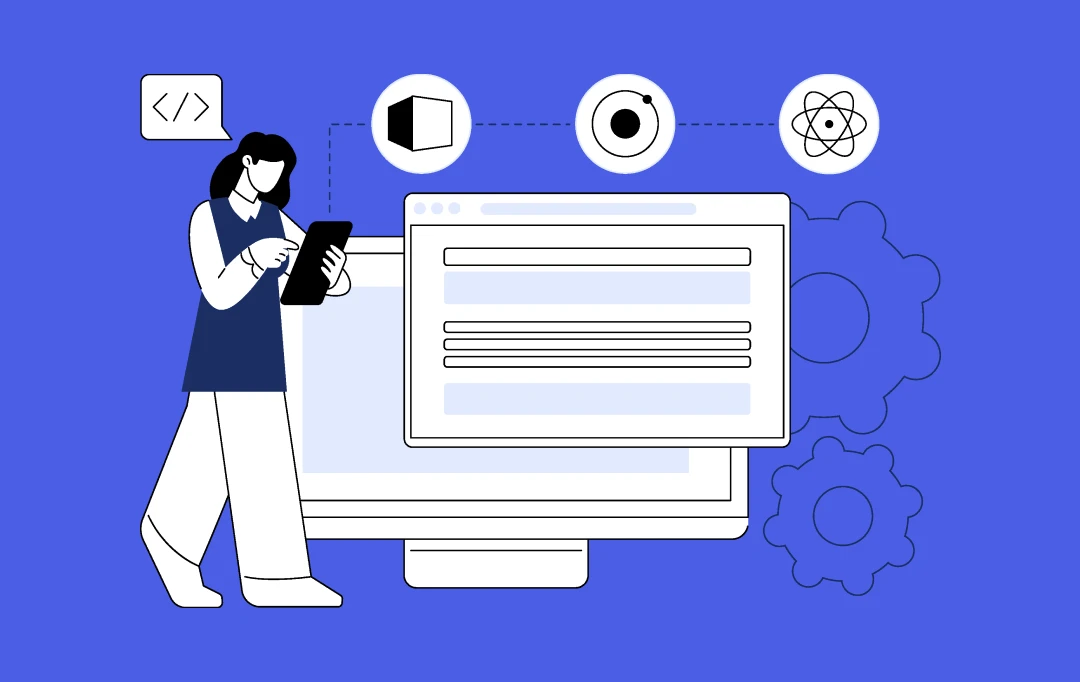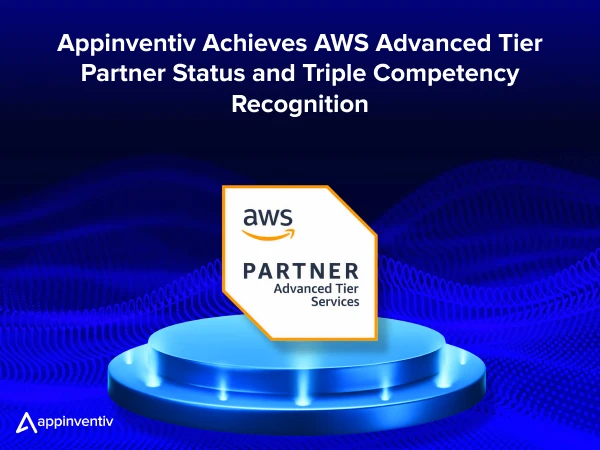- The Market Size: Why Now Is the Time to Get On Board
- The Evolution of Managed IT Services: From Break-Fix to Strategic Partnership
- Why Businesses Are Turning to Managed IT Services
- Rising IT Complexity
- Security and Compliance Pressure
- Cost Control and Predictability
- The Shift Toward Scalability
- Focus on Core Growth
- What Makes Managed IT Services Worth It
- Improved Operational Efficiency
- Stronger Data Security
- Predictable IT Costs
- Access to Expert Support
- Business Continuity and Reliability
- Scalability and Flexibility
- Better Focus on Core Operations
- How Managed IT Services Work: What to Expect
- 1. Onboarding and Assessment
- 2. Transition and Setup
- 3. Setting Service Expectations
- 4. Round-the-Clock Monitoring
- 5. Handling Issues and Escalations
- 6. Regular Reports and Reviews
- 7. Continuous Improvement
- Understanding the Cost to Hire Managed IT Services Providers
- Factors That Shape the Cost to Hire IT support services
- How to Choose the Right Managed IT Services Provider?
- Check Their Track Record
- Evaluate Response and Support Times
- Assess Security and Compliance Standards
- Look for Scalability
- Understand the Pricing Model
- Ask About Proactive Maintenance
- Gauge Communication and Cultural Fit
- Challenges Businesses Face with Managed IT Services and How to Resolve Them
- The Future of Managed IT Services: What Businesses Can Expect
- Smarter Use of Automation and AI
- Security That Bounces Back Fast
- Cloud as the Default
- Better Decisions from Real Data
- A Push Toward Greener IT
- Partnerships, Not Vendors
- Why Appinventiv Is the Partner Businesses Trust for Managed IT Services
- FAQs
Key Takeaways
- Managed IT shifts businesses from constant fixes to confident, growth-ready operations.
- The global surge in demand shows it’s the smarter, faster way to scale securely.
- The best providers don’t just manage systems but become part of your team.
- Predictable costs, real-time support, and stronger security make IT stress-free.
- Clear communication and accountability turn challenges into lasting partnerships.
- The future of IT management is intelligent, automated, and built on trust.
Imagine this – your business is scaling fast, new clients are coming in, and everything looks great on paper. But behind the scenes, your systems are dragging their feet. The Wi-Fi goes down during a meeting, a security update gets missed, or a server decides to crash on the one day you need it most. Sounds familiar? That’s the point where most business leaders pause and think, “Maybe I need more than just an IT guy. I need someone to actually manage this.”
The problem is, running IT in-house isn’t as simple as hiring a few tech folks. You’re suddenly dealing with maintenance schedules, software patches, data backups, and compliance checks that never seem to end. Every time something breaks, the focus shifts from growing the business to fixing the mess. It’s frustrating, especially when you know your team’s time could be spent on strategy and clients, not cables and configurations.
This is where you hire managed IT services providers to change the game. Instead of reacting to problems, you get a team that prevents them. They handle your networks, security, and support round the clock, quietly making sure everything runs the way it should. You don’t have to worry about downtime, data loss, or missed updates. It’s like having a full IT department without the overhead – just experts who’ve got your back, keeping your business moving forward.
In this blog, we’ll dig into why managed IT services are becoming essential for modern businesses. We’ll talk about how they help you save costs, improve security, boost performance, and give you the freedom to focus on what actually matters – that is growing your business, not managing your systems.
Let’s build a system that works for you, not against you. It’s the right time to bring in the experts and keep your business running without pause.
The Market Size: Why Now Is the Time to Get On Board
The numbers clearly show why businesses worldwide are turning to managed IT services today. According to Grand View Research, the global managed services market was valued at $335.37 billion in 2024 and is expected to reach $731.08 billion by 2030, growing at an impressive CAGR of 14.1% from 2025 to 2030. That kind of growth doesn’t happen by chance but happens because companies everywhere are realizing that managing complex IT environments on their own is slowing them down.
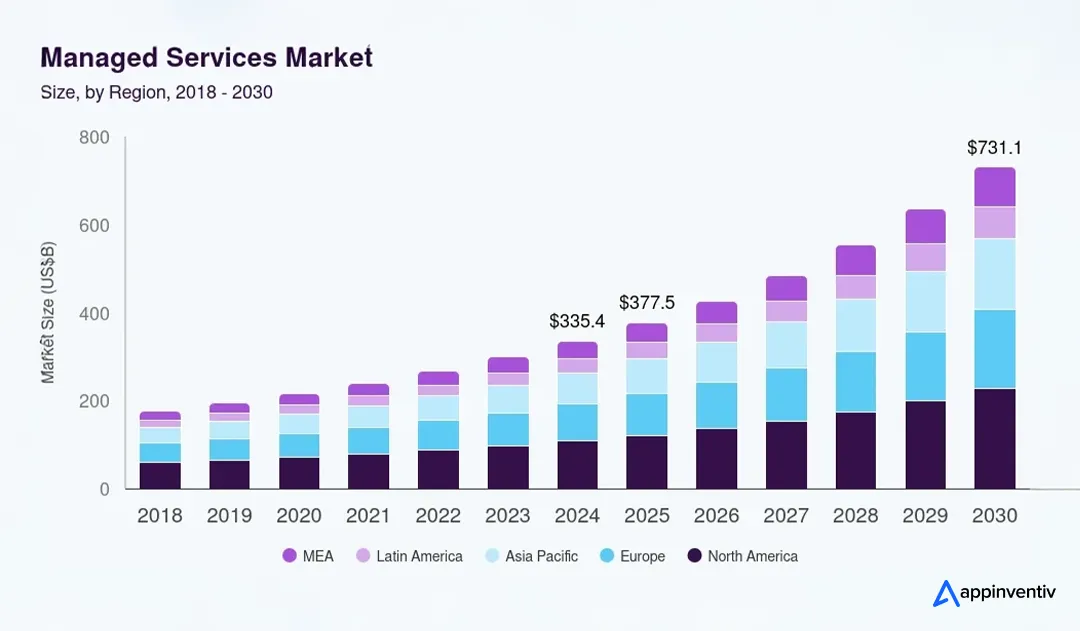
Modern businesses run on technology and when that technology breaks, performance, security, and customer trust take a hit. That’s why more leaders are choosing to hire IT support services or outsource IT services instead of managing everything in-house. Partnering with a trusted managed IT services provider or a full-scale IT managed services company brings stability, proactive monitoring, and round-the-clock protection. It’s no longer about cutting costs but about building agility and ensuring your systems are ready for whatever comes next.
The rapid rise in cloud adoption, cybersecurity threats, and automation tools is fueling the need for reliable managed network services. Businesses now prefer having experts who can handle infrastructure, data protection, and compliance without disrupting daily operations. The smartest move you can make today is to work with a managed IT support company that can anticipate issues before they happen and keep your operations smooth. These are the real, practical reasons to use IT managed services – consistency, security, and freedom to focus on growth.
When the market is expanding this fast, timing matters. Getting in early with the right managed service provider means your business doesn’t just keep up but gets ahead. So, if you’ve been on the fence about when to hire managed IT services for your business, this is your moment. The industry is booming, the technology is ready, and the future belongs to companies that make smarter IT decisions today.
The Evolution of Managed IT Services: From Break-Fix to Strategic Partnership
The way businesses handle IT has changed completely. What used to be a reactive “call when it breaks” model has now evolved into a proactive, continuous partnership. Instead of focusing only on fixing issues, modern IT management focuses on prevention, planning, and performance. This shift helps organizations stay resilient, secure, and ready for growth, not just operational survival.
| Approach | Traditional Break-Fix Model | Modern Managed IT Partnership |
|---|---|---|
| Primary Focus | Fix problems after they occur | Prevent issues and plan strategically |
| Support Style | On-demand troubleshooting | Continuous monitoring and optimization |
| Cost Structure | Unpredictable, pay-per-incident | Predictable monthly investment |
| Business Impact | Frequent downtime and delayed recovery | Minimal downtime and faster recovery |
| IT Role | Technical repair function | Strategic business enabler |
| Engagement | Transactional relationship | Long-term collaborative partnership |
| Security Management | Reactive response to breaches | Proactive risk detection and compliance focus |
This transformation explains how managed IT became a smarter, proactive model. But understanding the shift is only half the story – the real question is why so many businesses are choosing it today. Let’s explore that in detail next.
Why Businesses Are Turning to Managed IT Services
If you look around, one thing stands out – technology doesn’t just support businesses anymore, it drives them. But keeping every system stable, secure, and up to date is a full-time job on its own. That’s why more companies are starting to hire managed IT services instead of trying to handle everything internally. It’s no longer just a backup plan; it’s become a way to stay competitive, lower risks, and build stronger, more reliable operations.
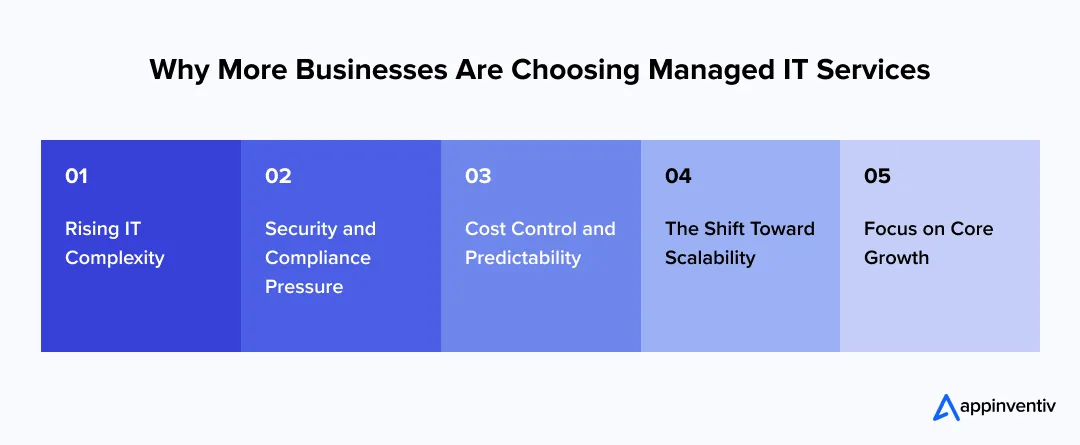
Rising IT Complexity
As a company grows, so does the complexity of its technology. There are more tools, more platforms, and more data to manage. For in-house teams, this quickly becomes overwhelming. A managed IT services provider steps in with the expertise and automation needed to simplify it all. They monitor systems, ensure smooth performance, and keep every process connected. When you hire IT support services, your team can stop putting out fires and start focusing on the work that actually grows your business.
Security and Compliance Pressure
Cloud cybersecurity challenges have grown to the point where even one missed update can cause real damage. Add to that the rising number of compliance rules, and it’s clear why many companies are looking for help. Working with a managed IT support company gives you access to experts who monitor systems round the clock, detect threats early, and manage compliance from end to end. A reliable managed service provider keeps your data protected, offers IT infrastructure management and your business audit-ready without slowing operations down.
[Also Read: Understanding the Regulatory Compliance Implications for Cloud Businesses]
Cost Control and Predictability
Building an internal IT team can get expensive fast. Hiring specialists, buying tools, and covering downtime all add up. Partnering with an IT managed services company helps turn those unpredictable costs into a fixed, monthly structure. You always know what you’re spending, and you gain a team that prevents problems before they disrupt your business. This is one of the most practical reasons to use IT managed services – better budgeting and fewer surprises.
The Shift Toward Scalability
Modern businesses need flexibility. One month you’re expanding, the next you’re streamlining operations. With managed IT services for businesses, you can scale easily without rebuilding your IT setup from scratch. Whether it’s adding more users, expanding into new locations, or managing hybrid teams, the right partner adapts fast. Many organizations are also turning to managed network services to maintain smooth connectivity between teams, systems, and customers.
Focus on Core Growth
When your technology just works, everything else moves faster. By deciding to outsource IT services, business leaders can finally step away from constant troubleshooting and get back to focusing on customers, strategy, and innovation. A professional IT support services partner quietly takes care of the systems that keep your operations running. It’s not about handing over control but about freeing your time to grow what really matters: your business.
What Makes Managed IT Services Worth It
You’ve seen why companies are switching to managed IT services, now let’s get into what they’re actually getting out of it. The truth is, availing managed services isn’t just about fixing what’s broken. It’s about helping your business run smarter, smoother, and stronger every single day. Let’s look into the benefits of hiring managed IT services in detail below:
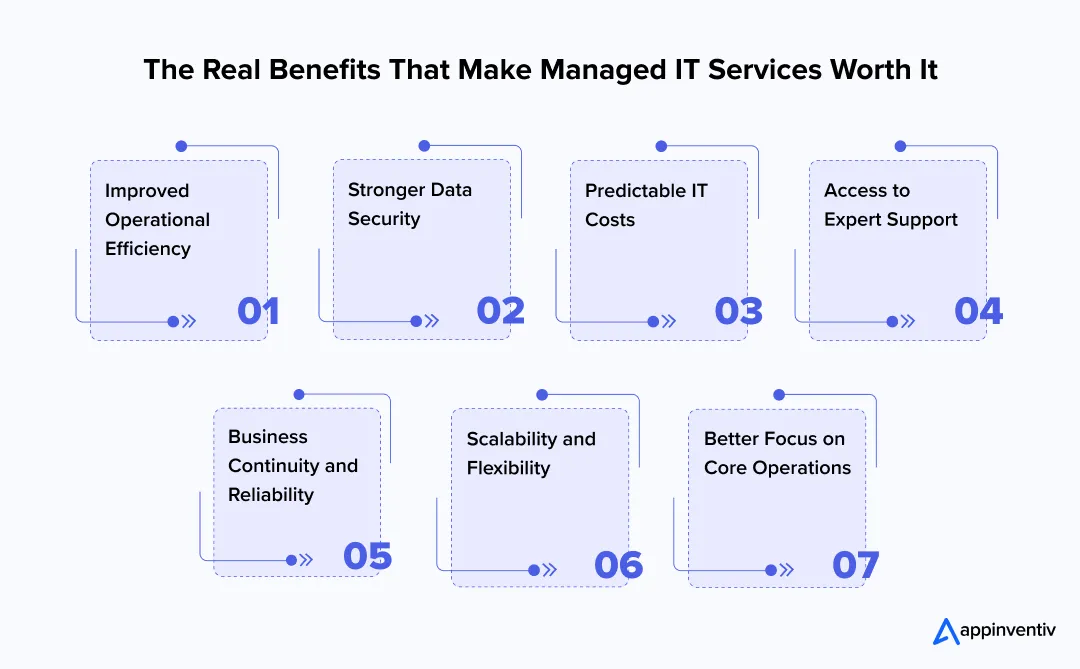
Improved Operational Efficiency
When you hire managed IT services, you bring in a team that knows your systems better than anyone else. They keep everything running quietly in the background – monitoring servers, updating software, and catching problems before you even notice them. Your team spends less time troubleshooting and more time getting real work done.
Stronger Data Security
Security isn’t just a checkbox anymore; it’s survival. A managed IT services provider keeps your data locked down with firewalls, monitoring tools, and recovery systems that protect against threats day and night. They make sure your information stays safe and your reputation stays clean.
Predictable IT Costs
When you’re running your own IT setup, costs pop up when you least expect them – a new license here, an emergency repair there. Working with a firm offering managed IT services for businesses turns that chaos into something steady. You get a simple plan, one predictable cost, and fewer surprises eating into your budget.
Access to Expert Support
Technology moves fast. Having experts who understand it all, cloud, security, networks, gives you an edge. When you hire IT support services, you gain people who’ve already solved the problems you’re about to face. Their experience saves you time, money, and plenty of stress.
Business Continuity and Reliability
Every minute of downtime costs money. A good managed service provider doesn’t just fix issues; they stop them before they happen. With constant monitoring and quick response times, they keep your business up and running when it matters most.
Scalability and Flexibility
Growth brings change – new locations, more users, heavier data loads. With managed IT services for businesses, scaling becomes simple. Your IT adjusts with your plans, whether you’re expanding fast or just starting to streamline.
Better Focus on Core Operations
The biggest win? You finally get your time back. When you outsource IT services, your team isn’t stuck dealing with updates, cables, or crashes. A professional IT support services team handles it all so you can focus on customers, strategy, and growth, the parts of the business that truly move the needle.
How Managed IT Services Work: What to Expect
When a company signs up for managed IT, things don’t just switch overnight. It’s a steady process that begins with understanding your systems and ends with building a rhythm that keeps everything running without surprises. Here’s how it usually unfolds:
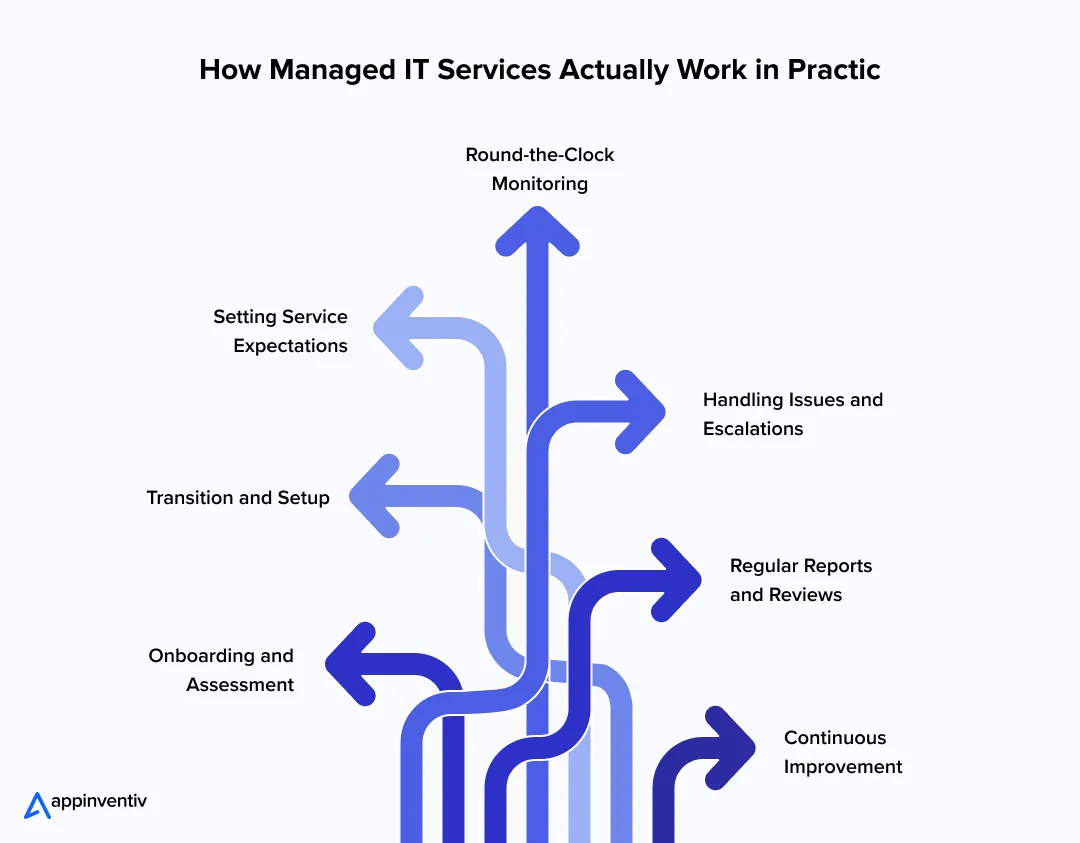
1. Onboarding and Assessment
The first few days are all about getting to know your setup – servers, software, data flow, everything. The provider checks where things stand, what’s slowing you down, and what needs tightening. You’ll get a snapshot of your current IT health and a plan that shows exactly what will be done first.
2. Transition and Setup
Next comes the shift. Monitoring tools are installed, data backups are tested, and user access is sorted out. The aim here isn’t to overhaul everything but to bring stability. Most businesses barely notice the change because the work happens in the background while operations continue as usual.
3. Setting Service Expectations
Once systems are in place, both sides agree on how the support will work – what’s covered, response times, and how emergencies are handled. These are written out clearly so everyone knows what to expect and when to expect it.
4. Round-the-Clock Monitoring
From here on, your systems stay under watch. The provider tracks performance, installs updates, and steps in early when something looks off. Most issues are handled before you even hear about them. It’s quiet, steady maintenance that keeps things moving.
5. Handling Issues and Escalations
If something serious does come up, it’s handled through a clear path. Smaller issues go to the helpdesk, bigger ones move straight to senior engineers. You’ll know who’s fixing it, what’s being done, and how long it’ll take. No endless back-and-forth.
6. Regular Reports and Reviews
Each month, you’ll see reports that break down system health, security checks, and tasks completed. These aren’t just numbers but will help you see what’s improving and what still needs work. Many providers also sit down with you quarterly to talk about upgrades and plans for the next phase.
7. Continuous Improvement
Once the basics are stable, the focus shifts to long-term growth. Maybe that means adding new tools, improving workflows, or planning a cloud move. The idea is to keep your technology in step with your business, not chasing behind it.
Understanding the Cost to Hire Managed IT Services Providers
Let’s be real – before you bring anyone new into your business, you want to know what it’s going to cost. Managed IT isn’t a one-size-fits-all service, so there’s no magic number that works for everyone. Still, most businesses pay somewhere between $100 and $250 per user each month for ongoing support and system management. Larger setups with heavier data loads or specialized tools can go higher, but the difference usually comes down to how complex your systems are and how much help you actually need.
What makes the cost of managed IT services worth it is the predictability. You’re not waiting for something to break and then scrambling to pay for emergency fixes. You’re paying for peace of mind – steady support, fewer outages, and a team that’s always on watch. When you add up the time saved and the stability gained, it often ends up cheaper than hiring a full in-house team or dealing with downtime losses.
Factors That Shape the Cost to Hire IT support services
Size of your business
The more people using your systems, the more machines, licenses, and network points that need attention. A ten-person team doesn’t need the same setup as a two-hundred-person firm, and pricing adjusts accordingly.
Type of services included
Not every company needs everything. Some only want basic system monitoring, while others add full cybersecurity management, cloud maintenance, or help desk coverage. The more areas handled, the higher the total bill but you can for sure expect fewer gaps later.
Customization level
A setup built from scratch to fit your tools and workflows will always cost a bit more than a standard plan. It takes time for engineers to understand your environment and design something that fits naturally.
Complexity of your infrastructure
A business running simple cloud tools is easier to maintain than one juggling old servers, hybrid systems, and custom databases. More moving parts mean more upkeep.
Length of the contract
Month-to-month plans give flexibility but usually cost more. A longer partnership often comes with better rates because the provider can plan resources in advance.
Security and compliance needs
If you operate in fields like healthcare, banking, or education, the added security and audit requirements increase both workload and responsibility. That’s why those industries usually pay a premium.
At the end of the day, the real value isn’t in shaving off a few dollars but in knowing your business won’t grind to a halt when something goes wrong. Simply put, business continuity and IT support go hand in hand – one keeps you running, the other keeps you ready. Businesses must understand that managed IT isn’t just another bill; it’s the layer that keeps your operations steady when everything else around you changes.
How to Choose the Right Managed IT Services Provider?
Once you’ve decided managed IT is the way forward, now comes the tricky part – finding a team that actually fits your business. On paper, most providers sound the same. In practice, only a few deliver what they promise. The right managed IT services provider shouldn’t just manage your systems; they should feel like an extension of your team, someone you can rely on when things get messy.
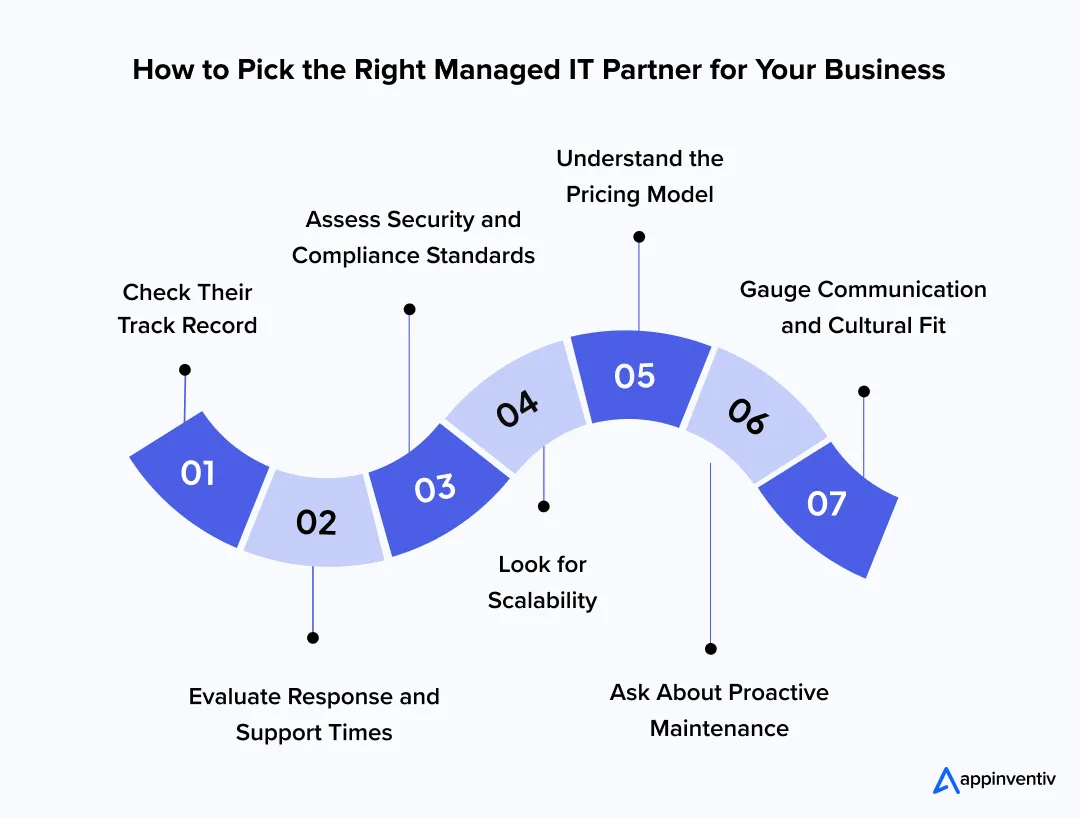
Check Their Track Record
Before signing anything, look at what they’ve done. Have they worked with businesses that look like yours? Do they have real examples or just fancy talk? A dependable IT managed services company will be open about the clients they’ve helped and the problems they’ve solved. Experience speaks louder than sales pitches.
Evaluate Response and Support Times
Every business says they offer “24/7 support,” but what does that really mean? Ask how fast they respond when something actually breaks. A reliable managed service provider should be reachable when you need them, not when it’s convenient for them. You’ll know you’ve found a good one when they treat your downtime like it’s their own.
[Also Read: How To Hire The Right Cloud Managed Service Provider? Key Considerations and Best Practices]
Assess Security and Compliance Standards
Technology is great – until someone breaks in. Before you bring in a managed IT support company, ask how they handle security. Do they keep systems patched and monitored? Do they help you stay compliant? You don’t want promises; you want proof that they take your data seriously.
Look for Scalability
Your business today might look nothing like your business in a year. Choose a partner who can move with you. A good managed IT services for businesses setup should flex when you grow – adding new tools, users, or branches without slowing you down.
Understand the Pricing Model
You don’t want surprises on your bill. Make sure you understand what’s included and what’s extra. Ask straight questions and expect straight answers. A good provider talks about money the same way they talk about technology – clearly and without dodging.
Ask About Proactive Maintenance
The best IT teams don’t wait for disasters but stop them before they happen. When you hire managed IT services, look for a partner that keeps an eye on things all the time. You shouldn’t have to call them when something breaks; they should already be fixing it.
Gauge Communication and Cultural Fit
This one’s underrated but huge. You’ll talk to this team often, so how they communicate matters. If they make you feel confused or brushed off, move on. The right hire IT support services partner listens, explains, and makes you feel like they’re in it with you, not just billing you.
Appinventiv’s Insight
From our experience, the best IT partnerships aren’t built on tools but on understanding. Every business runs differently, and the right solution always starts with knowing how you work before deciding what to fix. That’s the approach we take in every engagement.
Challenges Businesses Face with Managed IT Services and How to Resolve Them
Even with the best setup, managed IT isn’t a plug-and-play solution. Businesses often face a few bumps when adapting to this model, especially during the first few months. Most of these challenges come down to communication, expectations, and alignment, not the technology itself. Here’s a clear look at what can go wrong, why it happens, and how to fix it early.
| Challenge | Why It Occurs | How to Resolve It |
|---|---|---|
| Lack of Transparency | Some providers don’t share enough visibility into what’s being done day-to-day, leaving business leaders unsure of progress. | Set up regular reporting schedules and review meetings. Ask for access to monitoring dashboards or status updates so you always know what’s happening. |
| Unclear Service Boundaries | Businesses assume everything IT-related is covered, but most providers have defined scopes and exclusions. | Review the Service Level Agreement (SLA) carefully. Clarify gray areas upfront and document extra services that may need separate agreements. |
| Slow Response Times | Providers juggle multiple clients and may take longer than expected to respond. | Define response timelines in the SLA and establish an escalation protocol for urgent cases. Keep open communication with your account manager. |
| Cultural or Communication Gaps | Different work styles or unclear communication can create friction between internal teams and the IT partner. | Choose a provider whose communication style matches yours. Use dedicated channels and regular syncs to stay aligned. |
| Security and Data Ownership Concerns | Handing over control of critical systems can raise questions about data safety and privacy. | Discuss how data is stored, accessed, and backed up before signing the contract. Insist on compliance with your industry’s standards. |
| Resistance to Change | Internal teams may feel threatened or uncertain about working with an outside provider. | Involve key staff early, explain the benefits, and show how the provider supports and wouldn’t replace them. Collaboration builds trust. |
| Hidden Costs or Contract Surprises | Some agreements leave out details about upgrades, add-ons, or overage charges. | Ask for a full cost breakdown before signing. Review renewal terms yearly to ensure pricing still matches service value. |
Whatever hurdles your business faces, we’ll shape a managed IT strategy built around your goals, your systems, and your pace.
The Future of Managed IT Services: What Businesses Can Expect
Managed IT has changed a lot, and it’s still changing fast. It’s no longer just about fixing computers or keeping servers running. It’s about helping a business stay steady while everything around it keeps shifting. Over the next few years, that’s going to matter even more.
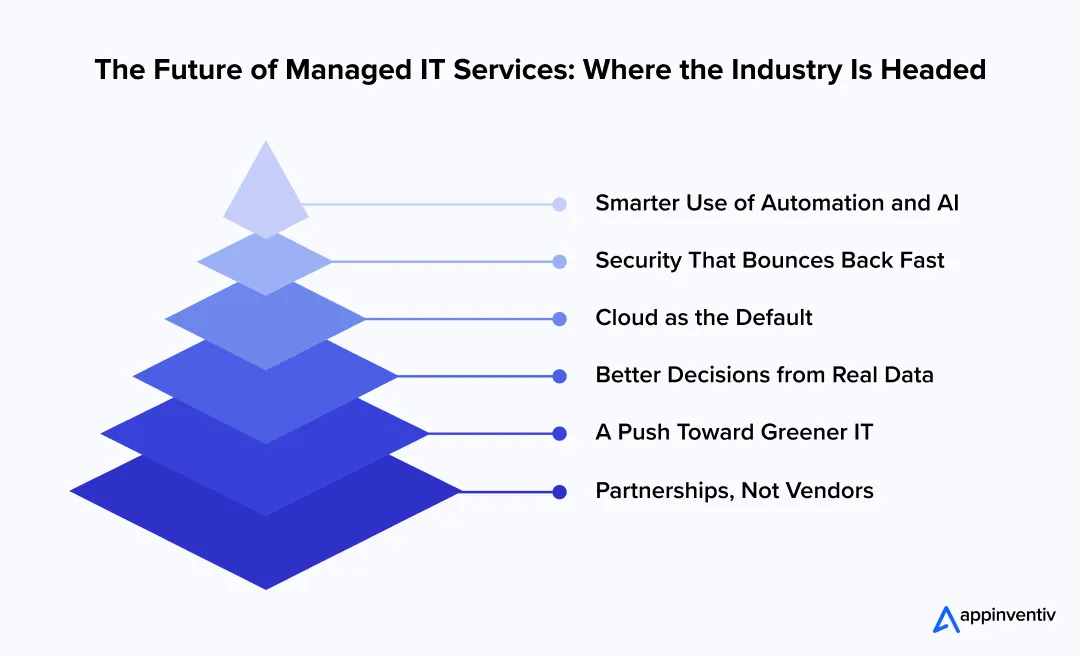
Smarter Use of Automation and AI
Automation isn’t new, but it’s finally becoming useful in the everyday side of IT. Routine updates, system checks, and load balancing will happen on their own. The real people behind it will focus on planning and risk, not on watching screens all day. It doesn’t replace your IT team but will take the boring work off their plate so they can think ahead.
[Also Read: Intelligent Automation: How Should Enterprises Get Started?]
Security That Bounces Back Fast
Attacks aren’t slowing down. The difference now is how fast companies can recover. That’s the next big thing – recovery, not just defence. Managed providers are building recovery systems and backup layers right into normal operations. When something hits, you get back up before most people even notice.
Cloud as the Default
Most businesses already use a mix of cloud and on-prem tools. The trick is managing both without the chaos. That’s where modern managed IT services fit in. They’ll handle those mixed setups quietly, moving data where it needs to be, keeping access smooth, and making sure you don’t overspend on storage you don’t use.
Better Decisions from Real Data
Instead of running reports no one reads, future IT partners will show you plain numbers that matter, such as uptime, response speed, cost savings. You’ll see what’s working and what’s wasting money. That kind of visibility will drive better calls on upgrades and budgets.
A Push Toward Greener IT
There’s also pressure building around energy use. When businesses hire managed IT services providers, they would want them to cut waste, leading to fewer idle servers, smarter cooling, and recycled hardware. Saving power saves money, so this one’s practical as much as it’s responsible.
Partnerships, Not Vendors
The biggest shift won’t be in tech at all. It’ll be in how companies work with their providers. The good ones won’t just offer managed IT services; they’ll act like part of your leadership team. You’ll plan together, review together, and make calls together. That’s where trust really builds.
Why Appinventiv Is the Partner Businesses Trust for Managed IT Services
When companies look for a long-term IT partner, they don’t want another vendor sending reports – they want people who actually understand what it takes to keep a business running. That’s where Appinventiv stands apart. We don’t just manage systems; we take ownership of how those systems support your goals. From startups moving fast to enterprises running global networks, we’ve built managed IT setups that keep things stable, secure, and always ready for what’s next.
Our strength comes from how we work, not just what we offer. Every project starts with listening. We learn how your business operates before touching the technology. Once we understand your workflow, we design a setup that fits naturally into it. That’s what makes our managed IT services different – they aren’t off-the-shelf plans; they’re built around your reality.
We also believe that support means more than fixing problems. It’s about staying one step ahead. Our teams monitor, review, and adjust continuously, using real-time data to prevent disruptions before they happen. Whether it’s handling cloud migrations, network monitoring, or cybersecurity updates, our managed application services for businesses work quietly in the background while you focus on customers and growth.
And finally, trust is what makes it all work. Over the years, we’ve delivered IT stability for clients across finance, retail, healthcare, manufacturing, and more, not by promising perfection but by showing up every time it matters. Appinventiv isn’t here to sell a service. We’re here to build long-term partnerships that make technology simpler, smarter, and a genuine asset to your business. Get in touch with our experts now!
FAQs
Q. Why should you hire managed IT services?
A. Because there comes a point when doing everything yourself stops making sense. In the early days, it’s easy to keep an eye on your systems, allowing you to understand what’s running and who’s using it. But as the business grows, the cracks start showing. Updates get missed, something breaks, and before you know it, your team’s spending half the day fixing what shouldn’t have gone wrong in the first place.
That’s where managed IT steps in. You hand over the heavy lifting to people who do it every day.
- They monitor everything quietly in the background.
- Fix issues before they interrupt work.
- And free you up to actually run your business, not its backend.
It’s not about giving up control; it’s about getting your time and focus back.
Q. What are the benefits of hiring a managed IT services provider?
A. The first benefit to hire IT support services providers is peace of mind – the kind you don’t realize you’ve lost until things just work again. When IT stops being the constant “what if,” it changes how your team operates. Systems stay online, files don’t vanish, and there’s always someone on standby when something feels off.
But there’s more that defines the importance of managed services:
- Costs become predictable instead of random emergencies.
- Your tech starts supporting growth instead of slowing it down.
- You can plan ahead, not just react.
Over time, that consistency becomes your biggest advantage.
Q. How do managed IT services help businesses grow?
A. Growth needs structure. You can’t expand when your systems crash every time new users log in. Managed IT gives you that foundation which is steady, secure, and scalable.
It means you can:
- Launch new offices or remote teams without worrying about setup.
- Rely on data protection that doesn’t buckle under pressure.
- Let your people focus on innovation instead of troubleshooting.
When your digital foundation is strong, everything built on it moves faster and cleaner.
Q. What should you look for when hiring a managed IT services provider?
A. Start with trust. Not in the marketing sense – real, practical trust. You want a team that listens first and talks later. Someone who asks what your business does before they recommend a single tool.
Things to notice:
- Do they explain tech in simple terms, or hide behind jargon?
- How do they respond when you ask about problems – confident or defensive?
- Have they handled companies your size or in your industry before?
You’ll know you’ve found the right one when it feels like working with someone, not hiring under someone.
Q. How much does it cost to hire managed IT services?
A. There’s no one price tag and anyone who gives you one instantly probably doesn’t understand your setup. Costs depend on how complex your systems are and how much coverage you need.
Here’s what most businesses find:
- It’s usually a monthly partnership, not a pay-per-incident.
- Smaller teams might pay a few hundred dollars; larger ones, more.
- The real value isn’t in the fee – it’s in avoiding downtime that costs thousands.
It’s like maintenance on a car: regular tune-ups cost a little, breakdowns cost a lot.
Q. When should a business switch to managed IT services?
A. Honestly, before you hit the panic stage. Most companies wait until something big fails, such as a data loss, a system crash and then make the switch. The smart ones do it when they notice the early signs: slow systems, constant fixes, or one IT person doing the work of five. That’s usually the point where you realize your business has outgrown your setup.
Q. What services are typically included in managed IT services?
A. It covers most of what keeps your operations alive and secure but varies per the provider. In general, you can expect:
- 24/7 system and network monitoring
- Regular updates, patches, and data backups
- IT infrastructure management
- Security checks, access control, and malware protection
- Helpdesk support for day-to-day issues
- Cloud management and compliance assistance for the bigger picture
It’s the digital equivalent of having a full IT department, just one that doesn’t take sick days or skip updates.


- In just 2 mins you will get a response
- Your idea is 100% protected by our Non Disclosure Agreement.

Capital Structuring and Tech Investments: What Enterprises Must Consider in 2026?
Key takeaways: Strategic capital structuring is essential to fund innovation without sacrificing financial stability. Each tech investment, like AI, cloud, cybersecurity, and sustainability, requires a tailored financing approach. Misalignment between capital structure and tech strategy can stall growth or strain margins. Hybrid and structured financing models help enterprises balance risk, control, and agility in 2026.…

Why Appinventiv Stands Out as the Leading Tech Consulting Provider for Digital-First Enterprises
Key takeaways: Appinventiv operates as a strategic partner, not just a service provider, focusing on business outcomes and ROI before technology. Success stories with global brands like KFC, IKEA, Adidas, etc., prove we tackle complex, enterprise-grade projects and deliver real results. Our capabilities span from AI-powered product building and cloud upgrades to custom software creation,…

Staff Augmentation vs In-House Hiring: Which Is the Better Model for Your Business?
Key takeaways: Cost Efficiency: Staff augmentation is less expensive when used in short-term projects, in contrast to in-house recruitment Scalability: Staff augmentation is swift at scaling teams, whereas in-house teams can be restricted Specialized Talent: With Augmentation, niche talent can be brought on at short notice; in-house is a long-term culture delivery mechanism. Control vs.…














